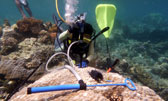




 The WAVES lab team with the whisker-like sensor
The WAVES lab team with the whisker-like sensor
Researchers at the Singapore-MIT Alliance for Research and Technology (SMART)[新加坡-麻省理工学院科研中心] have invented a marine robotics device that would certainly garner the ‘seal’ of approval from those in the industry and beyond. Dubbed ‘Whisker-like Sensors’, these sensors can enable an Autonomous Underwater Vehicle (AUV) to intelligently assess the state of its immediate surroundings by ‘feeling’ the flow, and hence detect important flow features that would be otherwise hidden in the ‘blind spots’ of current marine flow sensors especially while trying to manoeuvre.
In addition to this ability, the sensor readings can also be used to track moving objects. Like the seal whiskers, these sensors can be used to track the wakes (underwater tracks) left by other moving objects. For example, when a fish swims the tracks they leave behind form a series of interlaced vortices. These faint tracks can be picked up by the Whisker-like Sensors - something Acoustic Doppler Current Profilers (ADCP)* and other standard marine current sensors cannot do. The Whisker-like Sensors can effectively track several minutes-old wakes, regardless of operating depth.
As such, these sensors can potentially replace or enhance the expensive ‘eyes and ears’ on AUVs, submarines and boats that currently rely on cameras, sonars and current profilers to gather information about their surroundings. This first-of-its-kind, low-powered, compact (Whisker-like Sensors come in sizes ranging from a couple of millimetres up to fractions of a metre depending on the intended application) and low-cost (approx. USD$50/sensor to produce) sensors provide an advantageous alternative to traditional underwater sensors like underwater cameras which cannot see in murky waters; or sonars whose sound waves pose danger to some marine animals.
See News Release for more.